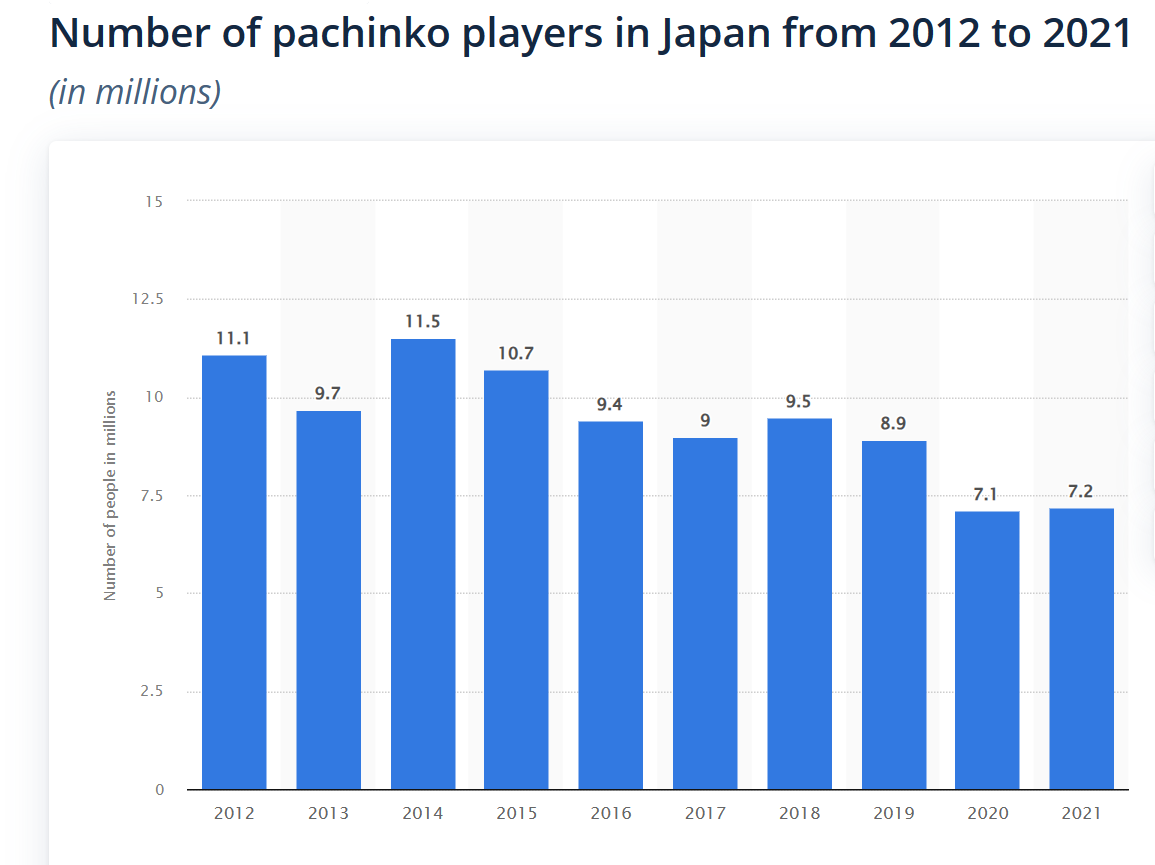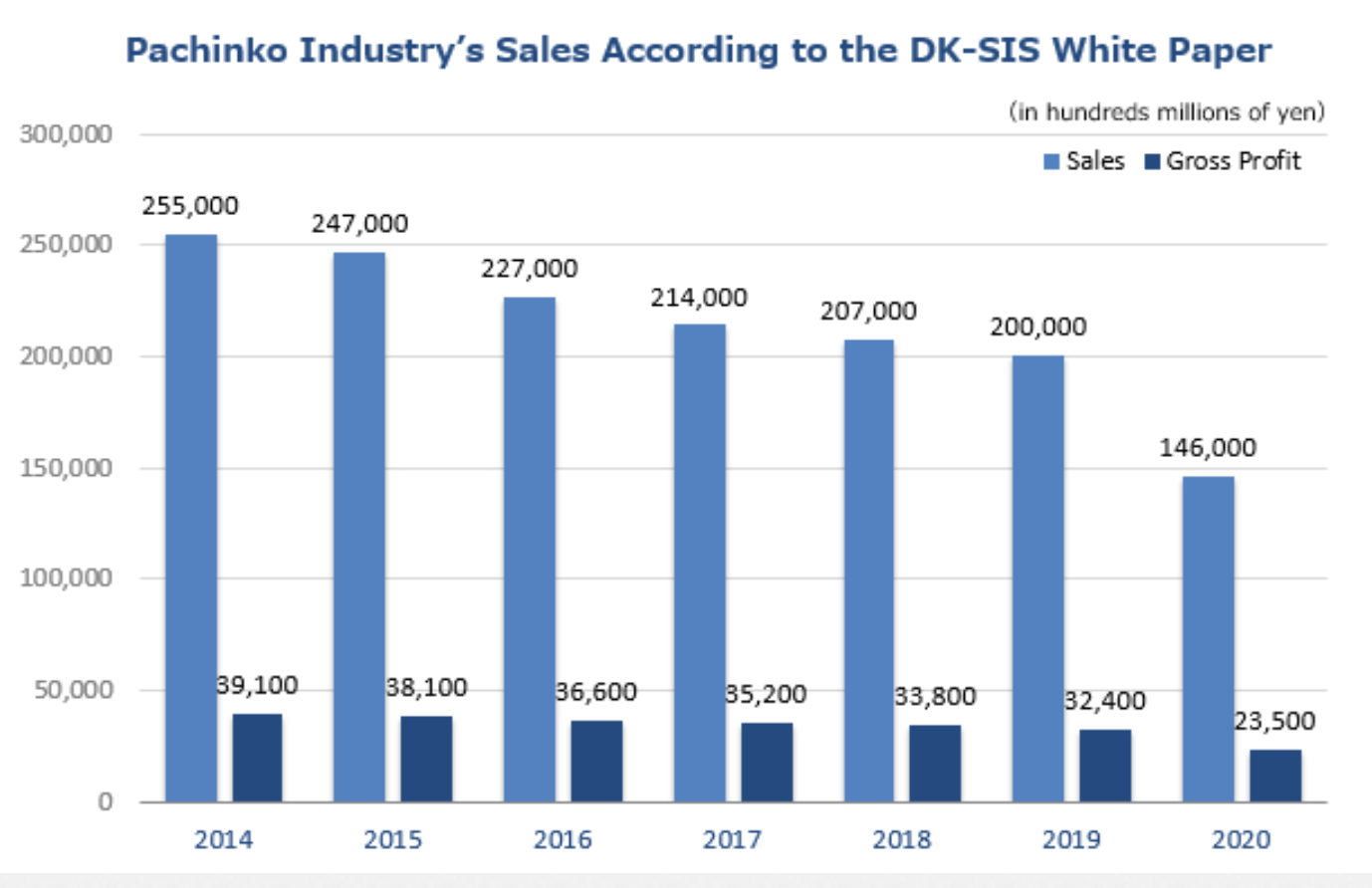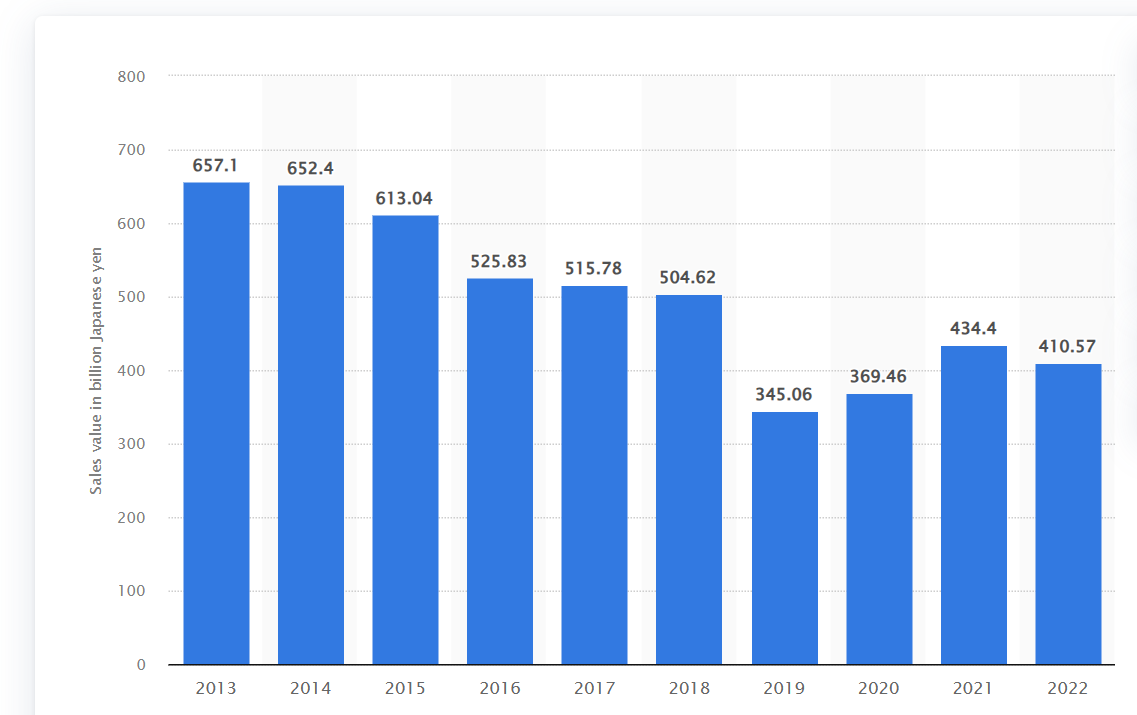Pachinko. It’s challenging to identify an industry that has faced more negative long-term predictions over the past few decades, given the numerous obstacles it encounters. You may have observed that pachinko parlors are gradually disappearing from cities, yet they are far from extinct. Why is this the case?
I did not initiate this discussion with a moral judgment about playing pachinko. Like any product, there are advantages and disadvantages. For instance, soy sauce, which pairs delightfully with sushi, can be lethal in excessive amounts.
The question I intend to pose is this: Can pachinko, a game deeply ingrained in the daily lives of the Japanese, withstand the numerous challenges it faces?
The following is the structure of this report:
- The present condition of the Pachinko industry
- My perspective on the future of the Pachinko industry
- If the answer to 2) is a positive one, which stock(s) could provide long-term positive returns. In other words, despite the uncertainties surrounding the industry, are there sufficient opportunities for patient investors? Note: Since all Pachinko parlors are privately owned, the potential stocks to invest in this sector would be those of equipment manufacturers or auxiliary service providers.
1. The current state of Pachinko/Pachislot industry
1) What is Pachinko?
Pachinko has its origins in American “bagatelle” pinball, which first came to Japan in the 1920s. It became a fixture in sweet shops, where it was given the nickname pachi pachi in reference to the pinging sound of the ball.
But it was only after WW2, when there was an excess of metal ball bearings and a dearth of other forms of entertainment, that pachinko became really popular. In the 1980s, the business embraced electronic games and parlors became much noisier and much more colorful, good places to zone out for an hour or two on the way between work and home.
There are currently two different pachinko equipment played at the pachinko parlors.
Pachinko
- It is similar to pinball, where a ball is launched onto the playing field using a lever.
- The ball can end up in the center, where pins are located. These pins can alter the ball’s route before it ultimately falls.
- When it reaches the bottom section, it may fall into pockets that indicate the amount you’ll win.
Pachislot:
- Pachislot is a slot game variation in Japan
- In Pachislot, you also spin the reels like in the traditional slot gameplay; however, you can control when the reels stop spinning with a button press.
- Several buttons represent the number of reels on the screen. Hitting each of them at the start of the round begins the spin, and hitting them a second time stops it.
In this report, the term “Pachinko” refers to both types of equipment, unless stated otherwise.
2) The current state of the Pachinko Industry
After work, some Japanese workers relax by playing Pachinko. Statista also reported that according to a 2021 survey, 40% of Pachinko players spent an average of ¥10,000 to ¥30,000 ($73 to $219) per daily parlor visit. Pachinko machines had an average daily win of ¥10,600 ($77.39).
While the pachinko industry is as vast as mentioned below, and deeply rooted in the daily lives of the Japanese, the industry has undergone many changes and faced numerous challenges in recent history.
2) Challenges:
- Demographic decline: Japan’s aging population and declining birth rate significantly affect the pachinko industry’s customer base. With fewer young people coming in, revenue and growth prospects diminish.
- Competition: Rising popularity of online gaming and other forms of entertainment, like casinos, could further divert attention from pachinko parlors.
- Social perception: Concerns about gambling addiction and pachinko’s association with negative social aspects might create additional obstacles for the industry.
- Regulation: Pachinko is technically classified as “adult entertainment”, not gambling, in Japan, alongside mahjong and other recreational activities involving money. This means it’s subject to specific regulations, including age restrictions (18+), licensing requirements for parlors, and limitations on payout ratios.
All the challenges mentioned above necessitate industry players to constantly innovate and create appealing content. However, the most negative and visible impacts stem from tighter regulations.
Over the last two decades, the government has consistently implemented stricter regulations. These are primarily aimed at combating addiction and money laundering by limiting pachinko prize payouts and operating hours. These regulations directly impact profits and result in reduced customer spending.
Here’s a summary of the key regulations implemented in the recent years:
2000:
- Youth Protection Law: Prohibited pachinko parlors from admitting anyone under 18 years old.
- Prevention of Organized Crime Law: Required pachinko parlors to implement stricter anti-money laundering measures.
2004:
- Specified Cash Transactions Reporting Law: Obligated pachinko parlors to report any cash transactions exceeding ¥1 million (approximately $9,000 USD).
- Pachinko Business Law Amendment: Introduced a points system for pachinko winnings, limiting the maximum daily payout to 46,000 points (equivalent to ¥46,000).
2006:
- Consumer Affairs Agency Guidelines: Established stricter guidelines for pachinko parlor operations, including prize payout ratios and advertising restrictions.
2012:
- Prevention of Public Gambling Addiction Law: Required pachinko parlors to implement measures to prevent gambling addiction, such as providing information and support services to customers.
- Pachinko Business Law Amendment: Reduced the maximum daily payout limit to 30,000 points (equivalent to ¥30,000).
2013:
- Specified Cash Transactions Reporting Law Amendment: Lowered the reporting threshold for cash transactions to ¥300,000 (approximately $2,700 USD).
2016:
- Integrated Resort (IR) Implementation Law: Paved the way for the introduction of casino resorts in Japan, including pachinko parlors with higher stakes and payouts within designated IR zones.
2018:
- IR Implementation Law Amendment: Delayed the opening of the first IRs until 2025 or later due to regulatory and licensing hurdles.
- The results of these tighter regulations are evident in steady decline in the number of players, pachinko industry sales and profits.
1) The number of players.
The player number has been on a general downward trend.

(source: Statista)
2) Sales and gross profits of Pachinko Industry

(Source: Daikoku Denki Strategic Information System (known as DK-SIS and part of Daikoku Denki, a provider of computer system to pachinko halls). DK-SIS is the industry’s only service system to help pachinko hall operators formulate effective management strategies).
According to the above graph, CAGR of the industry sales and gross profits from 2014 to 2020 were negative 8.9% and 8.1%, respectively.
3) Equipment Sales

(Source: Statista, Pachinko machines market sales value in Japan FY 2013-2022 as of 1/5/24)
In the fiscal year 2022, the sales value of the pachinko machines market in Japan amounted to approximately ¥ 410.6 billion The sales value of the pachinko machines market had been contracting in the past years with a brief recovery in 2021.
3) However, despite the observed declining trend, Pachinko’s undeniable popularity cannot be overlooked.
1. The business is worth U.S. $130billion per year: The market size of the pachinko industry in 2020 was ¥14.6 trillion .
2. Equivalent of 3.14% of Japan’s annual GDP: Japan’s GDP for 2022 was $4,231.14 billion. Therefore, the pachinko industry represents about 3.14% of Japan’s GDP.
4. 1.5X the size of Japan’s export car industry: In 2021, Japan exported $88.6B in cars
5. There were 7.2 million Pachinko players in 2021 (6% of 124.6MM population of 2021)
4) The reasons behind Pachinko’s appeal
By understanding the complex factors that fuel its appeal, we gain a deeper insight into Japanese culture and the unique relationship it has with this controversial yet captivating form of entertainment.
Cultural Significance:
- Socialization and community: Pachinko parlors serve as informal gathering places, fostering a sense of community and belonging. They offer a space for socializing and casual interactions, particularly for individuals who might not feel comfortable in traditional social settings.
- Stress relief and escapism: The repetitive nature of pachinko can be meditative and calming, providing a temporary escape from everyday pressures and anxieties. This aspect resonates with many in Japan’s fast-paced and demanding work culture.
- Skill and chance: Some players claim that Pachinko combines elements of skill with a significant dose of luck, appealing to the Japanese cultural appreciation for both calculated play and unpredictable outcomes.
Social Acceptance:
- Accessibility and inclusivity: Pachinko parlors are typically open late and readily accessible, catering to a diverse range of players, regardless of age, income, or social background. This inclusivity contributes to their widespread appeal.
- Cultural integration: Pachinko has woven itself into the fabric of Japanese culture, appearing in popular media, influencing fashion trends, and even inspiring themed amusement parks. This normalization further reinforces its popularity.
2. The next phase of Pachinko industry
Smart pachinko machines A Digital Shift in a Classic Game
1) What are smart pachinko machines?
They’re the next generation of pachinko, replacing physical balls and medals with digital representations on a screen. Players navigate balls through a virtual pin field, but winnings are tracked electronically and redeemed through points or vouchers rather than tangible objects.
2) Why were they created?
Multiple factors drove the shift:
- Regulations: Japan’s 2020 anti-addiction laws aimed to reduce physical token payouts, paving the way for digital alternatives.
- Cost efficiency: The elimination of physical parts makes production and maintenance cheaper for manufacturers and operators.
- Data and innovation: Digitalization opens doors for collecting player data, offering targeted promotions and personalizing gameplay experiences.
- Environmental concerns: Fewer physical components mean less resource consumption and manufacturing waste.
3) Prospects and potential impact:
- Enhanced gameplay: Smart machines could allow for dynamic rule changes, new game models, and even integration with online contents, potentially attracting new players.
- Operational efficiency: Automated management of points and winnings could streamline operations for pachinko parlors.
- Addiction concerns: The shift away from physical rewards might offer some advantages in mitigating gambling addiction risks, although further research is needed.
- Uncertainty and challenges: The acceptance and long-term success of smart pachinko depend on player and public reception, regulatory adjustments, and the ability of manufacturers to deliver compelling and responsible gaming experiences.
Overall, smart pachinko represents a significant digital transformation in a traditional cultural pastime, although its full impact remains to be seen.
Sankyo (6417), a prominent pachinko equipment manufacturer in Japan, disclosed in its Q2 FYE 3/24 earnings call that the installation of smart pachinko machines has not met initial expectations. However, the adoption of smart pachislot machines is progressing well, largely due to several hit titles offered by these smart pachislots. Sankyo reports that smart pachislot installations now constitute 20% of the total pachislot installed base.
In conclusion, Sankyo’s observations highlight a crucial factor for the future success of the Pachinko industry: content. In this regard, pachinko is rapidly converging with video games, where popularity is determined by the appeal of the content. This trend suggests a potential transformation in the Pachinko industry, aligning it more closely with the dynamics of the video game industry.
4) Other Potential Opportunities in Pachinko Industry
The below changes can vitalize the industry in addition to Smart Pachinko evolution.
- Innovation: Adopting new technologies like VR/AR, cashless systems, and themed experiences could attract younger generations and enhance customer engagement.
- Diversification: Expanding into other entertainment sectors like bowling, arcades, or family-friendly activities could broaden the appeal and target new demographics.
- Tourism: Integrating pachinko with cultural tourism packages and highlighting its historical significance could attract international visitors.
- Responsible gaming: Actively promoting responsible gambling practices and collaborating with addiction prevention organizations could improve public perception.
- Consolidation: The industry might see mergers and acquisitions as smaller parlors struggle to survive, leading to fewer but larger operators.
3. What is Next
The legal overhung will not go away, potentially impacting operational costs and profitability. Japan is not be able to reverse population decline any time soon, and Pachinko might evolve into a niche market catering to older generations or enthusiasts, while younger demographics seek alternative forms of entertainment.
However, dare I say that these concerns are well known and priced in? During these tumultuous years, Sankyo has never incurred net losses and maintained strong balance sheet and dividend payout. At the event of the industry shrinking down to a niche industry with much smaller player base, Sankyo will likely enjoy the survivor benefits.
The following report will be the report on Sankyo itself. Please stay tuned.
[Disclaimer]
The opinions expressed above should not be constructed as investment advice. This commentary is not tailored to specific investment objectives. Reliance on this information for the purpose of buying the securities to which this information relates may expose a person to significant risk. The information contained in this article is not intended to make any offer, inducement, invitation or commitment to purchase, subscribe to, provide or sell any securities, service or product or to provide any recommendations on which one should rely for financial securities, investment or other advice or to take any decision. Readers are encouraged to seek individual advice from their personal, financial, legal and other advisers before making any investment or financial decisions or purchasing any financial, securities or investment related service or product. Information provided, whether charts or any other statements regarding market, real estate or other financial information, is obtained from sources which we and our suppliers believe reliable, but we do not warrant or guarantee the timeliness or accuracy of this information. Nothing in this commentary should be interpreted to state or imply that past results are an indication of future performance.